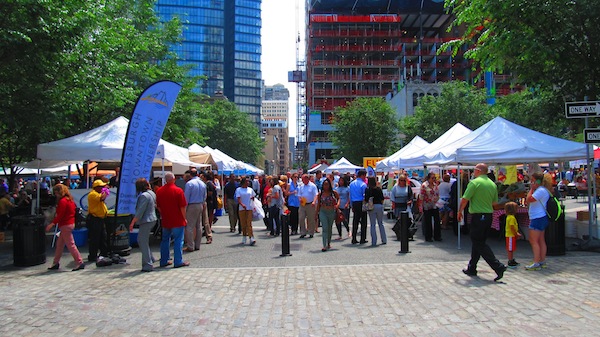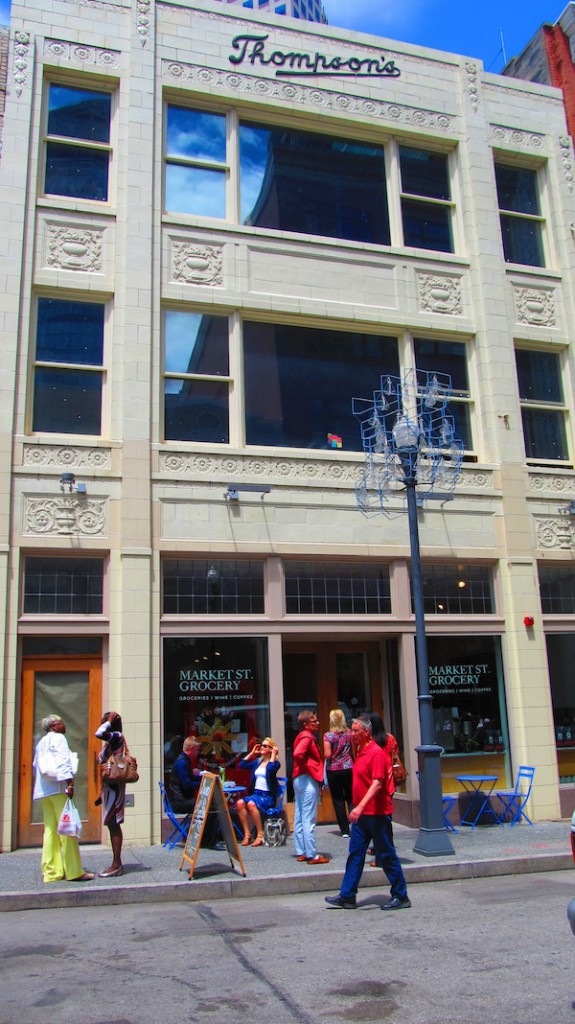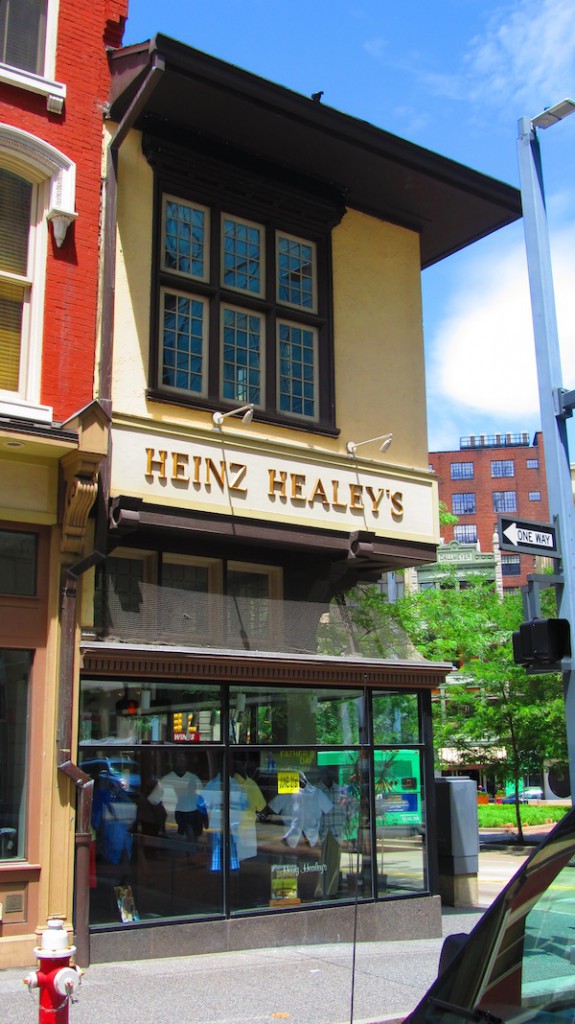
Latest News
-
Thank You PHLF Summer Interns

Simone D’Rosa, Sarah Collins, Molly Soffietti, and Andrew Hyatt; PHLF Summer 2015 Interns
“This summer, we were fortunate to have the help of Simone D’Rosa, Sarah Collins, Molly Soffietti, and Andrew Hyatt,” said PHLF Executive Director Louise Sturgess. We are grateful to them for volunteering their time to help with our Poetry and Art programs, Downtown’s Best, and Free Friday Walking Tours.
In addition, Andrew created a presentation on National Historic Landmarks; Simone and Sarah researched places associated with Pittsburgh Mayors and created an interactive map, and Molly researched and created tour content for our October Free Friday Walking Tour in the Gateway Center Renaissance Historic District. They also attended various preservation events and helped prepare materials for our Fall Architectural Design Challenge and Apprenticeship Program.
“Funding support from the BNY Mellon Foundation of Southwestern Pennsylvania is helping underwrite PHLF’s internship program in 2015, along with other career-based educational programs,” said Louise.
Intern Reflections
“Even though I have lived in Pittsburgh for most of my life, I had never felt the need to find out more about this city. I was often more enticed by foreign cities such as London and Paris. In a sense, I took Pittsburgh for granted. I learned more about Pittsburgh during this internship than I ever expected to and I am so glad that I did. By helping out with education programs that taught kids how to connect to their surrounding environment, I, too, learned a great deal about this city. I furthered my knowledge of the city when I was able to research the history of the Pittsburgh mayors. Thank you for this opportunity!” ––Simone D’Rosa (Architectural Studies/Preservation & Studio Arts, University of Pittsburgh)
“As a volunteer intern for PHLF, I was able to share my love for the city with people of all ages. I had the pleasure of working with some of the most dedicated individuals who share a passion for Pittsburgh’s past and a vision for Pittsburgh’s future.” ––Sarah Collins (Strategic Communications, Elon University)
“One often loses sight of the big picture while working towards a Master’s and toiling away in a lab all day. Every day PHLF encouraged me to explore Pittsburgh and rediscover why I am passionate about preserving our city, warts and all. Engaging with tour groups, both young and old, reinvigorated my enthusiasm and made me even prouder to display the city as both a thriving metropolis and a work of art.” ––Molly Soffietti (Historic Preservation Planning, Cornell University)
“Being involved with PHLF has truly been an amazing experience. I was able to see the incredible efforts that are being taken to revive the once-booming and bustling city and neighborhoods. Before this internship, I had no interest in Pittsburgh and its architecture and thought of it as a once-great city whose days were numbered. But PHLF showed me the true value of the historical significance of this city and how great it really is. The downtown districts and the surrounding neighborhoods full of different cultures and ethnicities really make Pittsburgh a unique city. The team at PHLF is truly a family that is so dedicated and driven to save the culture and heritage of the Pittsburgh region. It has been an honor to assist an organization that recognizes the power of preservation in keeping the community’s homes and stories alive for future generations.” ––Andrew Hyatt (Historic Preservation/Architectural History, Savannah College of Art & Design
-
Arts and Crafts Conference in Pittsburgh
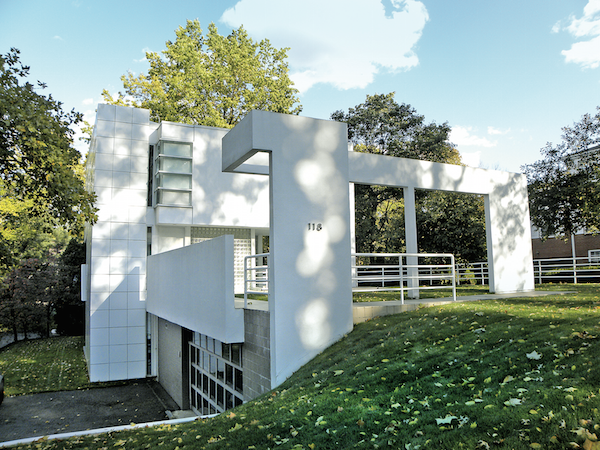 PHLF members and friends are invited to attend the 17th Annual Arts and Crafts Conference, which will be held in Pittsburgh from September 17 through September 20.
PHLF members and friends are invited to attend the 17th Annual Arts and Crafts Conference, which will be held in Pittsburgh from September 17 through September 20.Register for all four days or for any one day of this national conference sponsored by the Initiatives in Art and Culture (IAC), titled “Multiple Modernities: From Richardson to Wright and Beyond––The Arts and Crafts Movement in Pittsburgh and Environs.” As part of the “Beyond” portion of the conference, participants will be able to tour the Frank Giovannitti House, designed by Richard Meier in 1979-83, on Sunday afternoon, September 20.
Click here for a full agenda and to register. Please use the Promo Code PHLF to receive a conference discount of $475. Regular registration is $550.
Please note: the discount applies to those who register for the whole conference, not for one-day registrations. However, for those who are interested in attending more than one day but less than all four, then call the IAC at 646-485-1952. The IAC might be able to work something out and offers the warmest of welcomes to anyone who wishes to attend.
Conference organizer Lisa Koenigsberg, PhD, has planned an incredible agenda of tours and lectures (including one by PHLF trustee Lu Donnelly and one by Historical Collections Director Al Tannler). “Pittsburgh is astonishing,” said Lisa. “There is so much to showcase and explore.”
Participants will be touring Wilpen Hall in Sewickley Heights (protected by a PHLF easement); the Duquesne Club in Downtown Pittsburgh; several private homes, including an Arts-and-Crafts foursquare in Squirrel Hill featuring a superb collection of furniture and art; and several historic religious properties in Downtown, Shadyside, and Sewickley.
“This is a terrific opportunity to tour a selection of significant sites in the Pittsburgh region,” said PHLF Executive Director Louise Sturgess, “and to immerse yourself in the Arts and Crafts tradition.”
Conference partners include PHLF, the Frick Art & Historical Center, Carnegie Museum of Art, Fallingwater, and Kentuck Knob, among others.
Register today!
-
Leading the World in Preservation
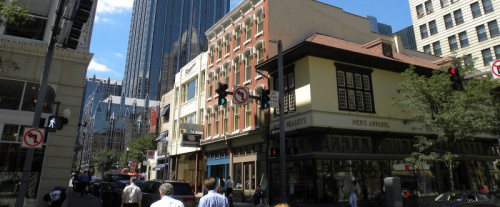
PHLF’s Market at Fifth featured as a major preservation achievement
PITTSBURGH, PA (Aug. 5, 2015) Pittsburgh has been named one of the 11 best and most livable cities in the world because of historic preservation according to Metropolis, a national magazine, which deals with “architecture and design at all scales.”
The magazine, which featured Pittsburgh in its July/August 2015 issue, selected Pittsburgh among a group of other cities including Toronto, Tokyo, Copenhagen, and Singapore, among others, which were selected for distinction in other areas ranging from walkability to culture, transportation planning, and landscapes.
“This is a great recognition for our city, which is showing the world that through adaptive reuse of our historic buildings, historic preservation is an underlying basis for social, human, and economic renewal,” said Mayor William Peduto.
Citing the decades-long efforts of preservationists, neighborhood activists, and specifically the work of the Pittsburgh History & Landmarks Foundation in battling the failed policies of urban renewal, the magazine noted that, “Pittsburgh, like so many other Rust Belt cities, faced huge hurdles with the decline of its steel industry. But it is overcoming many of these challenges thanks, in great part, to its preservation movements, neighborhood renewal projects, and active communities.”
“To have our City compared to others around the globe and be listed because of what we have achieved in preservation is an incredible distinction and honors the work of many citizens and organizations,” PHLF President Arthur Ziegler, said. “Our organization is especially honored to receive this recognition as we celebrate 50 years of our work in neighborhoods and communities across the region.”
The magazine featured PHLF’s Market at Fifth development in Downtown Pittsburgh, which combined quality retail and market-rate apartments in a LEED-Gold development, to highlight the ways in which the preservation community prevented “the demolition of 64 historic buildings in the core Downtown business area.”
In May, Mayor Peduto announced the completion of the restoration of 11 facades on 10 significant historic buildings in Downtown as part of the City’s ongoing revitalization of its core business district through historic preservation principles.
The buildings’ facades were restored by PHLF through a Redevelopment Assistance Capital Program grant from the Commonwealth of Pennsylvania awarded to the City through its Urban Redevelopment Authority.
-
Station Square: PHLF Greatest Saves
PHLF turned 50 on September 30, 2014. Intern Lauren Van Zandt, a Public History graduate student at Duquesne University, is sharing the stories of some of PHLF’s “Greatest Saves.” Help us celebrate 50 years of Pittsburgh renewal with a donation to our 50th Anniversary Fund. Click here.
 I first heard about Station Square when one of my public history classmates who was interning in the PHLF archives at the time, told me a story about the iconic half-circle stained glass windows in the main dining area of what is now the Grand Concourse restaurant. My friend told me about how, during PHLF’s restoration work in the 1970s, workmen used 400 cans of oven cleaner to reveal the original beauty of the glass that had been buried under years of soot and grime. The great glass skylight was uncovered like buried treasure.
I first heard about Station Square when one of my public history classmates who was interning in the PHLF archives at the time, told me a story about the iconic half-circle stained glass windows in the main dining area of what is now the Grand Concourse restaurant. My friend told me about how, during PHLF’s restoration work in the 1970s, workmen used 400 cans of oven cleaner to reveal the original beauty of the glass that had been buried under years of soot and grime. The great glass skylight was uncovered like buried treasure.It’s fitting that my introduction to PHLF was through one of its most groundbreaking projects. Station Square was Pittsburgh’s introduction to a new, more proactive and profit-generating approach to historic preservation in the city. It was PHLF’s first chance to put theory into action on a large scale.
Station Square’s dual success as a preservation initiative and commercial venture is especially impressive given that no one else was developing riverfront property when the project was initiated. (Times have changed, as one can see from South Side Works, the North Shore, and The Waterfront in Homestead.)
PHLF’s work at Station Square actually extends across the Smithfield Street Bridge; PHLF got the Smithfield Street Bridge lit at night, a first for Pittsburgh.
As prime developer of Station Square from 1976 to 1994, PHLF worked with others to restore and bring commercial tenants to five historic P & LERR buildings: the Terminal Building (which houses PHLF’s offices), the Express House (currently home to Buca di Beppo restaurant), the Gatehouse, the Freight House, and a multi-story warehouse that is now Commerce Court. In addition to saving old buildings, PHLF used new construction to attract visitors. PHLF facilitated the construction of a hotel, parking garage, and docks for the Gateway Clipper. By the time PHLF sold the 52-acre site to Forest City, a Cleveland-based developer in 1994, Station Square was one of the most visited attractions in Pittsburgh.

Though no longer under PHLF’s direct control, historic character permeates the development. PHLF created the beginnings of a Riverwalk of Industrial Artifacts, and the converter-dominated Bessemer Court anchors many of Station Square’s outdoor activities. The Ladies of Stone, sisters to the Ladies at the Children’s Museum on the North Side, greet visitors at entrances. Train cars in the Freight House and waiting room benches in the Grand Concourse harken back to the site’s original use. Beyond historical interest, these objects remind visitors of the city’s foundation that Pittsburgh’s modern rebirth has built upon.

Station Square demonstrates the potential for old and new to successfully integrate in a way that makes sense aesthetically and functionally— something that, in my own experience, has been unique to Pittsburgh. In many of the places I’ve lived, the fate of historic buildings seems to be limited to two options: preservation in amber or demolition. Living in Pittsburgh and interning at PHLF has been an education in the viability of historic preservation as a method for creating vibrant, beautiful urban environments.
As an intern, I got to explore Station Square and the P & LERR building but it was especially interesting when I helped out with one of the transportation tours for local elementary students. At the beginning of the tour I was totally focused on herding stragglers and the kids were engrossed with taking pictures with their phones. However, as we traveled through Station Square and up to Mt. Washington, both I and the students were inexorably drawn into the history and the scenery. From Station Square you could see the history of downtown written in the levels of scale and development across the Monongahela River, with smaller buildings nearest to the river transitioning to early skyscrapers along Fourth Avenue, to the huge modern towers of PPG Place and BNY Mellon Center.

As I reflected on my time, both as an intern and as a Pittsburgh resident while writing this article, it really struck me how representative Station Square is of the city. On the one hand, you have Pittsburgh’s industrial past, represented by artifacts like the Bessemer converter and the railroad buildings. On the other hand, you can see Pittsburgh’s future: commercial development and revival, a growing tourism sector, and views of Pittsburgh’s constantly evolving downtown skyline. I think Pittsburgh’s greatest strength is its ability to value and preserve its past while adapting to modernity and embracing new ideas like green technology. Interning at PHLF has really shown me how diverse, rich, and unique Pittsburgh is and I will always be grateful for the chance I had to get to know this amazing city.
-
Market at Fifth: PHLF’s Greatest Saves
PHLF turned 50 on September 30, 2014. Intern Lauren Van Zandt, a Public History graduate student at Duquesne University, is sharing the stories of some of PHLF’s “Greatest Saves.” Help us celebrate 50 years of Pittsburgh renewal with a donation to our 50th Anniversary Fund. Click here.
When I started working on this article I thought I would just drop in on my interview subjects during lunch on a Thursday. Big mistake––as anyone who’s ever been to Market Square on a summer Thursday would have warned me. In between the profusion of lunching workers, farmer’s market browsers, and photo-taking tourists, the whole area was packed. And, of course, my interview subjects were completely occupied with customers. One has to wonder if fifteen years ago, as stakeholders and city government battled over the future of the area surrounding Market Square, if anyone could have envisioned this kind of outcome for such a depressed and neglected area.
In 2000 the city proposed a $522-million scheme to transform 5½ acres of downtown into Market Place at Fifth and Forbes, a modern retail center anchored by big-box stores and national retailers. Had the plan gone through, over sixty historic buildings would have been razed and the character of Downtown would have been irrevocably altered. With the aid of community stakeholders and the National Trust for Historic Preservation, PHLF fought this demolition-as-revitalization approach and began working on an alternative.
Putting historic preservation principles into action, PHLF acquired three buildings at the corner of Fifth Avenue and Market Street in 2007 (160 Fifth Avenue, 489 Market Street, and 491 Market Street). These buildings became Market at Fifth, a mixed-use development that helped to revitalize and define the character of Market Square. PHLF utilized private funding and over $600,000 in tax credits to remodel and restore the buildings, and green technology to achieve a LEED-Gold rating. Nettleton Shoes and Heinz Healey’s Men’s Apparel now occupy the lower floors of the three original buildings, with market-rate apartments above. In addition, PHLF purchased the former Thompson’s Restaurant building in 2008 and renovated it, thanks to funding from the Allegheny Foundation, the Commonwealth of Pennsylvania’s Redevelopment Assistance Capital Program grant to the City of Pittsburgh, and Allegheny County’s Community Infrastructure and Tourism Fund. After much anticipation, the Market St. Grocery opened in April 2015 on the main floor of the Thompson Building, giving Downtown its only grocery––plus Gaby et Jules bakery, and a wine shop and bar.
After picking a less busy day to visit, I was able to speak with Scott Kresge of Nettleton Shoes. Mr. Kresge’s family has owned the business since 1929; it was located in the Union Trust Building for over seventy years as well as a brief stint in One Oxford Centre. Mr. Kresge has noticed a number of advantages to his Market Street location: the biggest is the boost that foot traffic and street entrances have for generating business. He also appreciates the “warmer feeling” of a small-scale Downtown and the unique architectural features the c. 1870 building affords. Mr. Kresge specifically requested that the historic brick wall in his store remain uncovered. Not only does it provide character to the store’s interior, but it becomes the photo backdrop for Mr. Kresge’s beautiful shoes!
Interviewing is hard work, so I popped into the new Market St. Grocery to refuel. There were a number of tempting breakfast options that morning (I’ll definitely be coming back to sample the French toast), but in the end I could not resist the call of the rainbow-hued macarons from Gaby et Jules. I had ambitions of bringing them home to take photos for the article, but I could only wait for twenty minutes before eating them.
I was also able to speak with Chas Schaldenbrand, manager of Heinz Healey’s. The store’s location on Fifth Avenue and setting has been a great attraction for clientele. The walls of windows are a big draw, showing off Heinz Healey’s menswear offerings and drawing in customers. Being Downtown has brought the store to its suit-wearing clientele, and customers appreciate the historic character and context of the 1908 building rather than a more modern setting.
While interning a PHLF, I’ve heard the phrase “human scale” mentioned a lot when talking about Downtown. As I walked home from Market Square munching on my macarons, I think I finally started to really get what it meant. Surrounded by towering skyscrapers, the historic buildings of Market Square are intimate and inviting in a way in which the monumental new architecture just can’t compete. As Downtown attracts more and more business, I hope that property owners and developers contemplating the next big tower remember that the human scale and historic context have tremendous value.
-
Community Engagement on Hunt Armory
By Molly Soffietti, PHLF Summer Intern
Graduate Studies in Historic Preservation Planning at Cornell University
On June 8th approximately 100 interested and concerned residents of Shadyside, developers, and preservationists met at Calvary Episcopal Church. The topic of discussion was the fate of the Hunt Armory located at 324 Emerson Street in Pittsburghu. Completed in 1916, the 90,000-square-foot former armory is in the process of being purchased by the City of Pittsburgh and the Urban Redevelopment Authority (URA) from the Commonwealth of Pennsylvania. A meeting with community members, led by Kyra Straussman, URA director of real estate, and City Councilman Dan Gilman, served as a time to brainstorm possible uses and concerns to be included in a future Request for Proposals for the site.Ms. Straussman emphasized that the project is one of preservation. The building is listed on the National Register of Historic Places and is also designated a City Historic Landmark. Retention of the facade is mandatory. Straussman also commented that while the historic status of the structure may limit alteration to the interior, it will provide opportunities for the use of Federal Rehabilitation Tax Credits in its potential redevelopment and adaptive reuse.
The lively discussion between residents included ideas for indoor recreation facilities and residential developments. Concerns were voiced regarding the noise pollution, traffic congestion, and parking created by a new development in the already-crowded street surrounded by Sacred Heart Parish and the DePaul School for Hearing and Speech. Suggested uses from the audience include an indoor velodrome, recreation space for nearby schools, or an indoor market.
The armory was once home to the 28th Infantry Division, the oldest division-sized unit in the armed forces of the United States. The “Keystone Division,” named after the keystone ornamentation on the building’s facade and on uniform lapels, fought in key battles in US history: Antietam, Gettysburg, The Marne, Normandy, and the Battle of the Bulge. The building still contains plaques memorializing the fallen from the 28th Division dating back to the American Civil War. The structure’s listing on the City Register, spearheaded by local veteran and Senator Jim Ferlo, was spurred by a desire to protect the memorials.
The Hunt Armory’s namesake, Captain Alfred E. Hunt, was a hero of the Spanish-American War. A chemist and metallurgist, Hunt is remembered for founding the Pittsburgh Reduction Company in 1888, renamed the Aluminum Company of America in 1907, and now widely known as ALCOA. A member of the Hunt Family, Todd M. Hunt, Jr., spoke briefly about the family’s desire to find the highest and best use for the site while preserving the historic structure.
The building has a capacity of 15,000 and was the largest auditorium in Pittsburgh until the completion of the Civic Arena in 1961. Presidents Harry S. Truman and Dwight D. Eisenhower both spoke to standing-room-only crowds at the armory.
Walter C. Kidney wrote of the Hunt Armory in Pittsburgh’s Landmark Architecture (PHLF 1997):
“Repeated Doric pilasters lend a magnificence, and yet delicacy as well, to a Pennsylvania National Guard artillery armory that has its neighbors the Alder Court apartment house and Sacred Heart Church. The great length of the building is broken up by many closely spaced verticals, and the scale is so ambiguous that one is pleasantly unclear whether this is a big building trying to look small or a small building trying to look big. Either way it is a dramatic feature of a quiet neighborhood street.”
A Request for Proposals for the site was distributed on June 20th. A five- to six-week submission period will follow. Straussman emphasized the importance of community engagement in the selection criteria for the developer. Community members, including a former show usher at the Armory, spoke of their memories of the site. The enthusiasm shown by local residents exemplifies the pride and commitment the community has for safeguarding cultural and architectural landmarks.
-
City Proclamation for PHLF
Councilwoman Natalia Rudiak and City Council presented a proclamation on June 23 to PHLF for its “Building Pride/Building Character” Trolley Tour that connects third-grade students with local government through a visit to Council Chambers and meeting with their Council representative and staff. Representatives from the Pittsburgh Public Schools, PHLF, and partnering organizations accepted the proclamation on behalf of more than 4,300 third-grade students who have participated in the program since 2007.
“The City-County Building is the first stop in our six-hour fieldtrip adventure,” said PHLF’s Executive Director Louise Sturgess. Students have the chance to meet and talk with their Council Representative who leads them in the Pledge of Allegiance. They also stop by the Mayor’s office to say “hello” and to see the portraits of all of Pittsburgh’s mayors. After visiting the Allegheny County Courthouse (and sometimes meeting the County Executive or judges), students board Molly’s Trolleys and drive to Point State Park, where they tour the Fort Pitt Museum and Fort Pitt Block House. The tour culminates in a ride up the Duquesne Incline, walk along Grandview Avenue to the “Points of View Statue,” and ride back down the incline.
Each historic landmark is associated with “character-building words,” and students try to be like the City-County Building (respectful, responsible, tolerant, proud); the Allegheny County Courthouse (robust, dignified, impressive); Fort Pitt Museum (disciplined, loyal); Fort Pitt Block House (a survivor, adaptable, caring); and Duquesne Incline (ingenious, cooperative, courageous).
PHLF created its “Building Pride/Building Character” Trolley Tour in 2007 as one of the field-trips and in-school activities available to some Pittsburgh Public Schools through the Commonwealth of Pennsylvania’s Educational Improvement Tax Credit (EITC) Program. Since 2007, PHLF has involved a total of 4,336 third-grade students and their teachers from 20 different Pittsburgh Public Schools.
Teachers and students often describe the Trolley Tour as “their favorite day of the year.”
To learn more about PHLF’s EITC program, click here.
-
PHLF Awards Four More Scholarships: 60 Winners Since 1999!
During a private reception on June 17 at a historic Woodland Road home, David Brashear, Chair of the Landmarks Scholarship Committee, introduced PHLF’s 2015 Scholarship recipients (front row, left to right): Brennan S. McCann, Jilliam F. Root, Deborah Monti, and Meghan J. Kokoski. Mr. Brashear is pictured here (top right) with the four winners and with nine former recipients. Each 2015 winner will receive a $6,000 college scholarship for book and tuition expenses, payable over four years.
Since 1999, PHLF has awarded 60 scholarships to a remarkable group of high-achieving students in Allegheny County who care deeply about the Pittsburgh region: 27 of those winners graduated from Pittsburgh Public Schools and 33 graduated from other schools within Allegheny County.
Here are brief profiles on the four newest scholarship recipients:
- Brennan S. McCann, from South Fayette High School, will be studying Aerospace Engineering at Embry-Riddle Aeronautical University. Brennan’s scholarship essay fondly reflected on many afternoons spent wandering the halls of the Carnegie Museum of Natural History. He hopes to “pursue science and discovery with the same stateliness and childish fervor” that seem to echo through the exhibits of the museum.
- Jilliam F. Root, from The Neighborhood Academy, will be studying Cell and Molecular Biology at West Chester University. Jilliam’s scholarship essay described Frick Park as a safe haven defined by a “kind atmosphere, beautiful scenery and friendly faces.” Whether she was practicing basketball with friends or seeking a quiet space to think, Jilliam remembers that the park played a significant role in her childhood.
- Deborah Monti, from Pittsburgh Allderdice High School, will be studying English and Political Science at Yale University. The Braddock Carnegie Library holds much more than books for Deborah, who volunteers there every Saturday to assist with a children’s clay class. For Deborah, the “grandeur and old time magnificence” of the library has a single purpose: “To bring people together and to foster creation and collaboration.”
- Meghan J. Kokoski, from Springdale Junior-Senior High School, will be studying Chemical Engineering at the Massachusetts Institute of Technology. In her scholarship essay, Meghan explained the influence of the Rachel Carson Homestead on her personal dream of becoming a chemical engineer. She referenced Rachel Carson’s famous words from Silent Spring: “In nature, nothing exists alone.” Meghan plans to keep these words in mind as she aspires to “preserve the natural world.”
Lead contributions from David and Janet Brashear, the Gailliot Family Foundation, Highmark Blue Cross Blue Shield, McSwigan Family Foundation, and Howard & Nell E. Miller Foundation made it possible for PHLF to increase its scholarship award in 2015 to $6,000 (payable over four years).
“Based on their essay and application,” said Mr. Brashear, “we know that each recipient cares about Pittsburgh and is likely to stay connected to the city and region no matter where he/she lives or works. Since applicants are asked to write about a place in Allegheny County that is important to them and that has affected them personally, we are connecting with the next generation of future leaders who share our values and realize that place matters.”
“Sixty-six people applied to PHLF’s Scholarship Program this year and many of the applicants were deserving of the scholarship award,” said Louise Sturgess, Executive Director of PHLF. “The essays were inspiring and the students had made outstanding contributions to their communities,” she added. Applicants wrote about “Woodville,” the Burtner House, Manchester Bidwell Corporation, the Benedum Center, Steel Valley, Dilworth School, Point State Park, North Park, South Park, Gus and Yia Yia’s in Allegheny Commons, and Allegheny Cemetery, among many other places.
“Our goal is to increase our Scholarship Fund through contributions from others so we can award more scholarships and increase the scholarship amount,” said Mr. Brashear. To contribute, visit: www.phlf.org or contact Mary Lu Denny (marylu@phlf.org; 412-471-5808, ext. 527).
The Landmarks Scholarship Program is the culmination of PHLF’s educational programs for thousands of students (pre K-12) and the beginning of its programs for adults. It gives Allegheny County students an incentive to excel in school, become involved in their communities, and express their commitment to this region in a meaningful way.
PHLF’s Scholarship Program is offered each year. Applications for the 2015-16 school year will be available in January 2016. Applicants must:
- live in Allegheny County;
- be a high school senior who has been accepted to a college or university;
- have a cumulative GPA at the end of the first semester senior year of 3.25 or greater;
- have a significant interest in local history, architecture, and/or landscape design; and
- write an essay describing a place in Allegheny County that is important to them; complete an application; and submit two letters of recommendation (one must be from a community representative).

